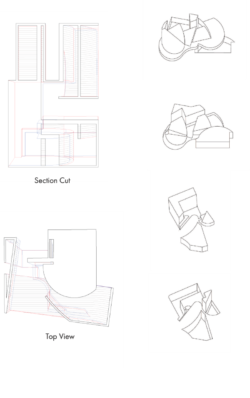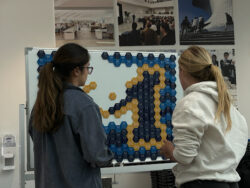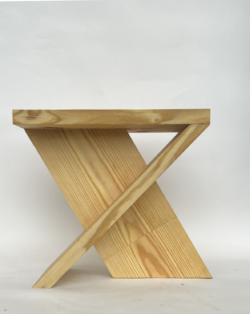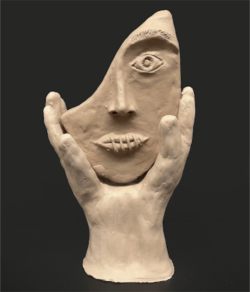


 Becoming an architect was a childhood dream Tala Dababna had nearly forgotten until it was time to decide on a college major. “Drawing and art always brought me joy,” she says. “In one of my early sketches, I depicted myself as an architect, donning a construction hat and proudly labeling the drawing ‘The Architect.’ Growing up, I also found myself engrossed in video games that involved decorating and designing virtual spaces. Through this experience, I realized the true power of architecture—the ability to bring together elements of design, math, problem-solving, creativity, and even a touch of business, all in one profession.”
Becoming an architect was a childhood dream Tala Dababna had nearly forgotten until it was time to decide on a college major. “Drawing and art always brought me joy,” she says. “In one of my early sketches, I depicted myself as an architect, donning a construction hat and proudly labeling the drawing ‘The Architect.’ Growing up, I also found myself engrossed in video games that involved decorating and designing virtual spaces. Through this experience, I realized the true power of architecture—the ability to bring together elements of design, math, problem-solving, creativity, and even a touch of business, all in one profession.”
Tala continues, “This sparked a renewed passion for architecture within me, and the thought of being able to create spaces that are not only functional but also visually appealing and inspiring became my driving force. I’m thrilled to have the opportunity to bring my diverse skill set and passions together to craft remarkable spaces that positively impact people’s lives.”
Tala, an undergraduate architecture student at University of Michigan Taubman College of Architecture and Urban Planning, is the recipient of the Michigan Architectural Foundation’s (MAF) Richard M. and Sidney K. Robinson Scholarship. The scholarship (offered in cooperation with the Huron Valley Chapter of the American Institute of Architects), is awarded to a University of Michigan undergraduate architecture student who aspires to a career that combines the roles of citizen and artist.
 “As citizens, we are uniquely positioned to understand and respond to the needs of our community,” says Tala. “In a time when affordable housing is increasingly scarce, we recognize the importance of designing spaces that are both affordable and sustainable. Citizens should also understand that economics should not compromise the quality of design, and that everyone deserves to experience spaces that are tailored to their needs, functional and aesthetically pleasing, and accessible to all.”
“As citizens, we are uniquely positioned to understand and respond to the needs of our community,” says Tala. “In a time when affordable housing is increasingly scarce, we recognize the importance of designing spaces that are both affordable and sustainable. Citizens should also understand that economics should not compromise the quality of design, and that everyone deserves to experience spaces that are tailored to their needs, functional and aesthetically pleasing, and accessible to all.”
What Tala loves most about architecture is the constant challenges and the opportunity for continuous learning it presents. She has spent her summer at Hopkins Burns Design Studio, an architecture firm specializing in historical preservation. “We often work with buildings that have rich backgrounds and significant cultural importance, and it’s truly fascinating to delve into the unique stories behind these structures,” she says. “The technologies and techniques used in the past differ greatly from what we employ today, and witnessing the progress we make in restoring and preserving these buildings is incredibly rewarding. Each project presents new opportunities to learn, grow, and leave a lasting impact on the built environment.”
 She continues, “I’ve come to realize buildings, in a way, are like time capsules, preserving the memories and history of the people who have experienced them. It’s a reminder that history never truly leaves us; it’s woven into the very fabric of these structures. Whether it’s an architectural technique or a child’s scribble on a wall, these remnants offer glimpses into the lives and narratives of those who came before us. The ability to contribute to the preservation of history while also creating functional and aesthetically pleasing spaces is a true privilege.”
She continues, “I’ve come to realize buildings, in a way, are like time capsules, preserving the memories and history of the people who have experienced them. It’s a reminder that history never truly leaves us; it’s woven into the very fabric of these structures. Whether it’s an architectural technique or a child’s scribble on a wall, these remnants offer glimpses into the lives and narratives of those who came before us. The ability to contribute to the preservation of history while also creating functional and aesthetically pleasing spaces is a true privilege.”
Tala states she wants to have a future architecture career characterized by growth, exploration, community engagement, and embrace diverse opportunities in different areas of architecture. “I am passionate about the field and hope to avoid setting limits on my path. I have a drive to create something groundbreaking and meaningful, and envision myself continuously exploring and expanding my horizons. Alongside my professional pursuits, I have a strong desire to give back to the community and contribute something new and innovative to the architectural landscape.”
Tala also has been exploring furniture making, and has designed a toddler’s chair and a stool, with plans to design and make more pieces in the future. According to Tala, “I can’t wait to see where my passion for architecture and furniture design takes me next!”
She is also enjoying the architectural degree program at Taubman, due in part to the diversity of subjects that allow her to explore various aspects of architecture, and professors who have been approachable, supportive, and have taken a genuine interest in her development as a student. “This personal connection with professors has allowed me to receive guidance, feedback, and mentorship that goes beyond the classroom,” said Tala. “Even for a larger school, there is a sense of community that has made a significant impact on my education and overall experience. It’s comforting to know that I am a valued member of a tight-knit community, and I can confidently say that I’m in the right place to pursue my passion for architecture.”

 MAF’s mission is to advance awareness of architecture and its impact on people’s lives. How does Tala think architecture impacts life? “
MAF’s mission is to advance awareness of architecture and its impact on people’s lives. How does Tala think architecture impacts life? “
Good architecture considers functionality, aesthetics, and overall well-being, while enhancing daily experiences,” she says. “It also shapes environments, creates lasting structures, prioritizes safety and convenience, and fosters community engagement and a sense of belonging. As an architect, I will focus on designing meaningful spaces that accomplishes these objectives, while holding cherished memories, providing comfort, and positively influencing people’s lives.”
photos, top to bottom: Tala; select images from her portfolio; Tala at school; images of some ofher furniture designs, and a sculpture made by Tala. While Tala does not have a single favorite piece of architecture, she is inspired by many incredible buildings and has a deep appreciation for the work of architects like Frank Lloyd Wright and Tadao Ando. She also notes creations of the firm Apaloosa Estudio de Arquitectura y Diseño as having a significant impact on her architectural journey. (picturedFrank Lloyd Wright’s Fallingwater; Tadao Ando’s He Art Museum; and Villa Luciérnagas, by Apaloosa Estudio de Arquitectura y Diseño.
